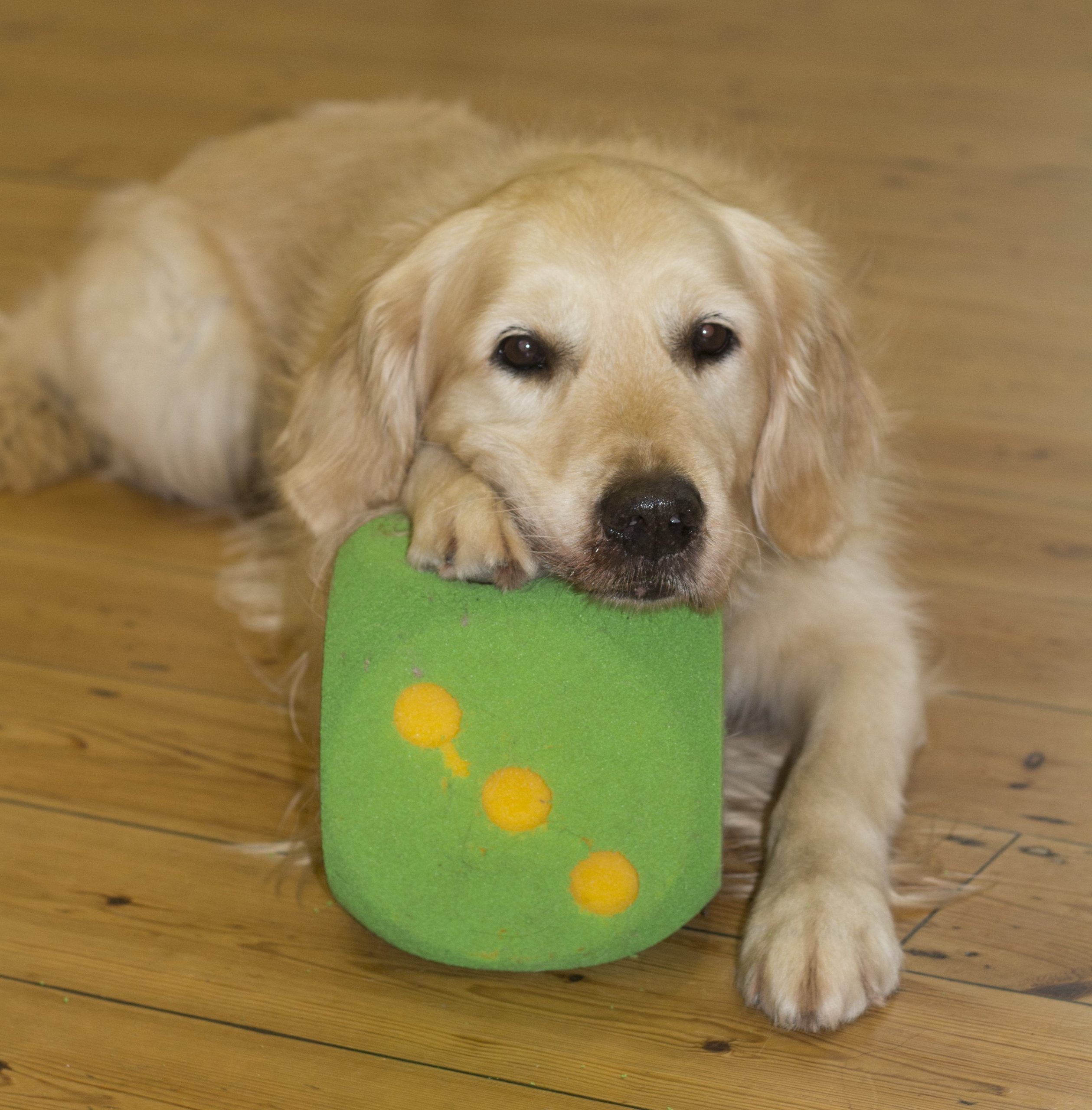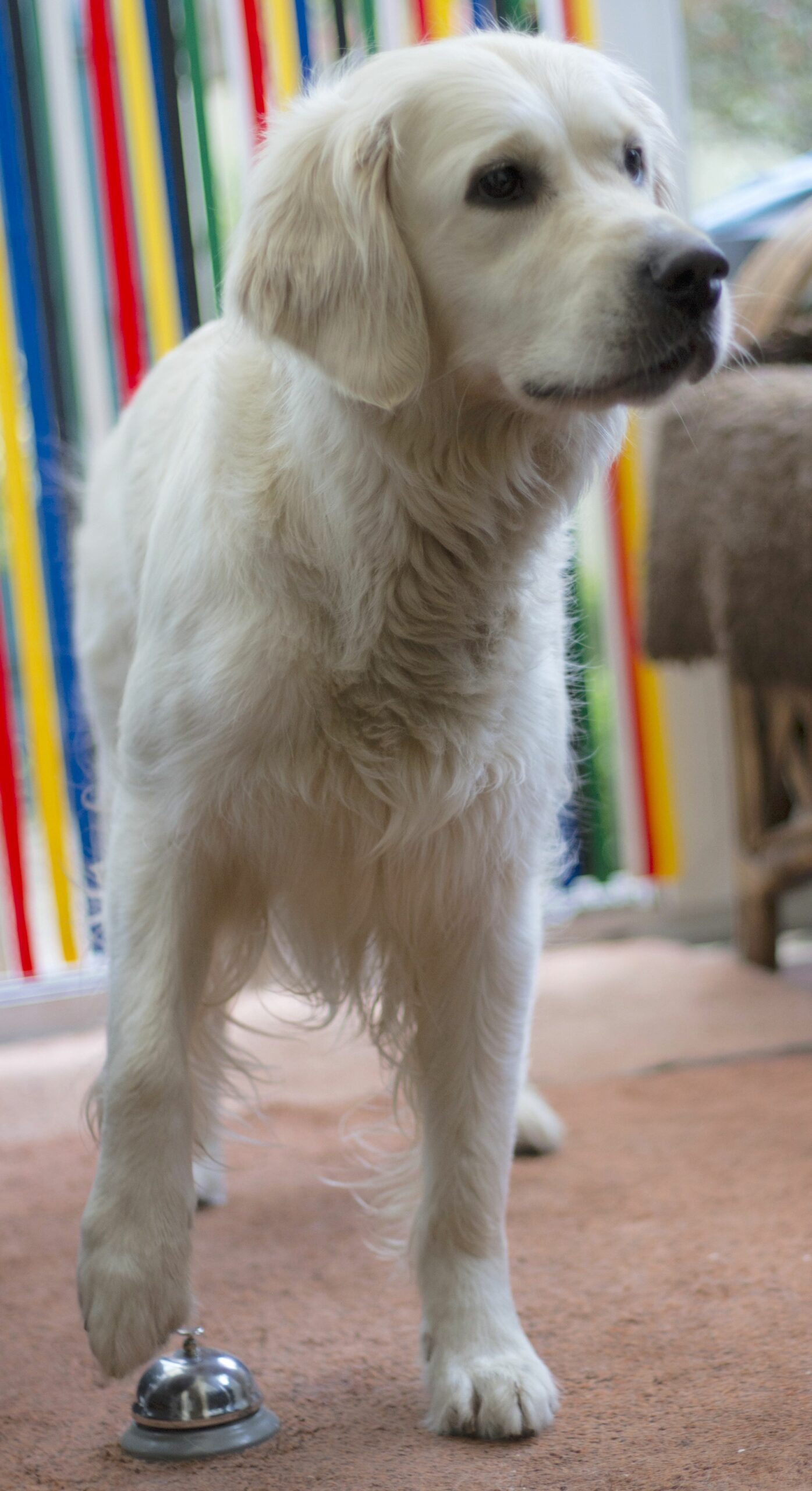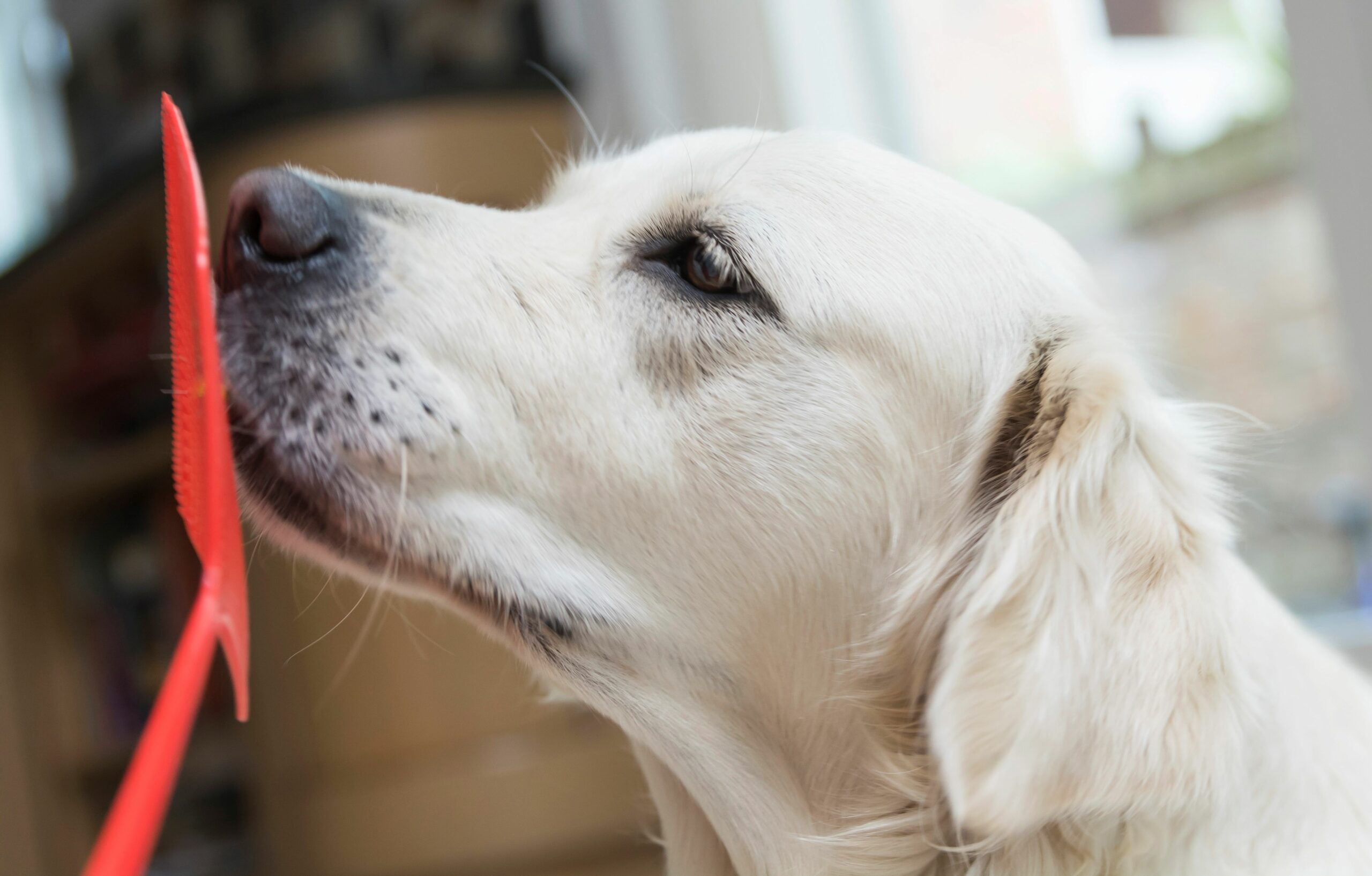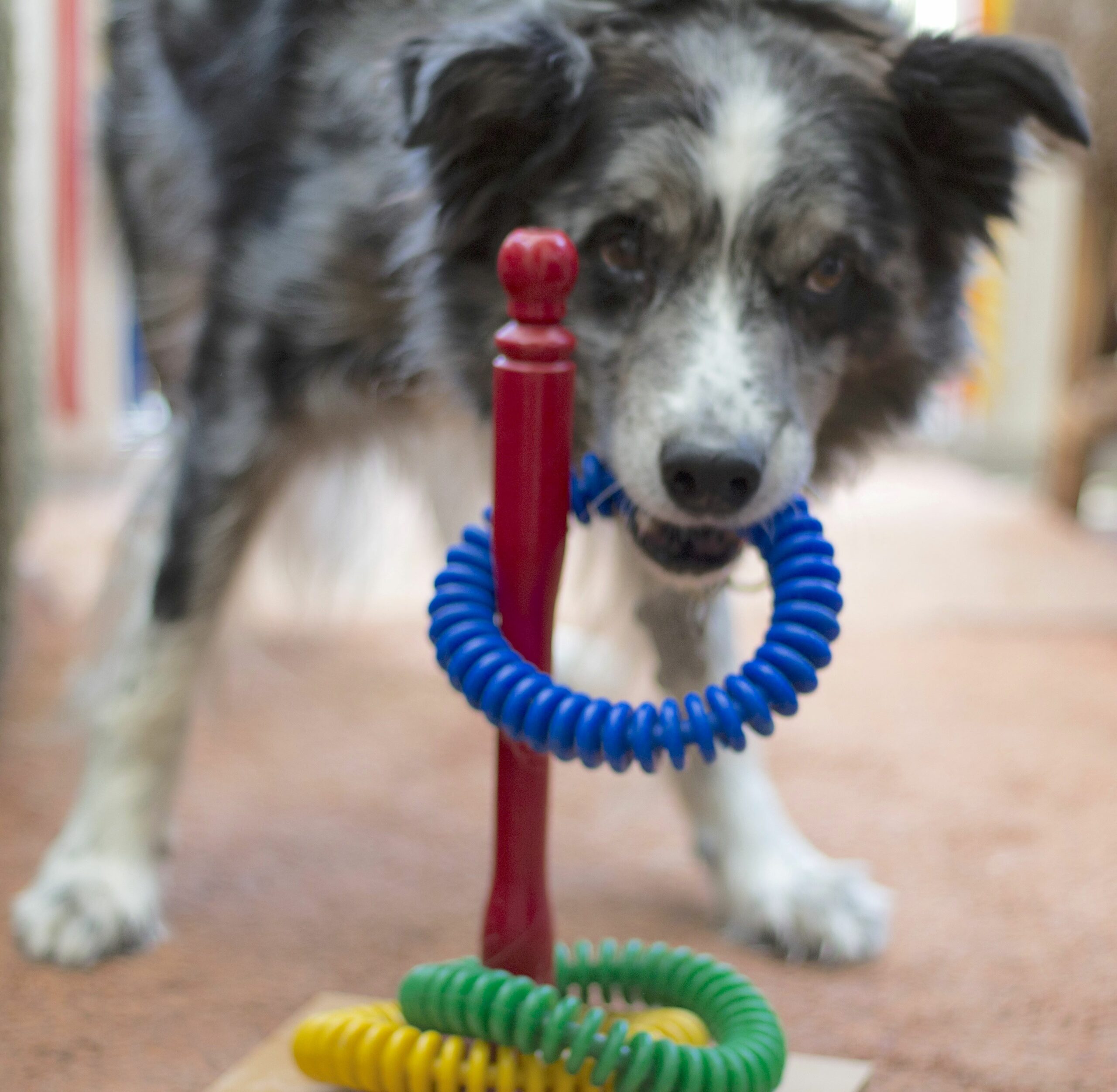Barks Blog
Building the ‘Super Learner’
By Kate Mallatratt

One of my behavior colleagues posed a very interesting question recently, “If you always set your dog up for success and aim for errorless learning, are you not stunting your dog’s ability for critical thinking, limiting his opportunity to enjoy problem solving and shortening his fuse for frustration?”
This excellent question raises several more in my mind: Can learning truly be 100 percent errorless?
Does setting up a learning environment for a successful outcome really have a detrimental effect on a dog’s learning ability?
Do mistakes actually benefit the dog?
Does avoiding errors mean a dog is less robust to face life’s challenges?
What does a ‘mistake’ mean to a dog?
We learn avoidance from our errors because we understand the concept of a mistake and its negativity, but what do our dogs learn from their ‘mistakes’?
Does trial and error only learning limit the behavior repertoire of our dogs?
Errorless Learning
The concept of nearly errorless learning was introduced by psychologist B. F. Skinner (1904 – 1990) in the 1930s. It is a teaching methodology that strives to keep errors to a minimum by prompting behavior to elicit the desired outcome. The opposite of errorless learning is trial and error learning, where learning happens from both mistakes and successes.
American psychologist E. L. Thorndike (1874 – 1949) is credited with the concept of trial and error learning or connectionism, where there is a direct connection between stimulus and response. This is how Mother Nature teaches and it can, at times, be a harsh and punishing way of learning.
Jump forward to the present day and Kay Laurence of Learning About Dogs brought us microshaping, a highly refined form of error reduced learning that sets up the dog for success every step of the way. She showed the world the art of breaking down behaviors into miniscule parts that are taught individually, and then pieced back together to produce behaviors that are robust, error free and of consistently good quality.
She taught us how targets can be used to successfully teach new behaviors to minimize errors and, most importantly, showed us that microshaped behaviors taught through error reduced learning are the product of happy, engaged learners.
Clicker Training
Most of us think of clicker training as positive – but is it always? Traditional clicker training is trial and error learning: the dog keeps trying until he hits upon the correct behavior, learning that the absence of the click means no reward – an error – and click means success.
Horse clicker trainer Alex Kurland talks of “the click that teaches.” But what does it teach?
As we reach for our clicker, we should ask ourselves some key questions:
- What is our dog learning at every step of the process when being taught a new behavior?
- What emotion is attached to the behavior?
- How many errors is our dog making?
- Is the dog happy, engaged, motivated and focused or is frustration driving new behaviors and if it is, does it matter?
Yes, it matters because frustration affects behavior and learning. The behavior rate might be as high as 80-90 percent errors against 80-90 percent successes in errorless learning. How many times can a dog fail before he gives up? It depends on the dog, but surely there must be a better way of communicating?
We often see the fallout of trial and error learning during free shaping when frustration levels rise. Dogs may revert to learned helplessness after cycling through their repertoire of known behaviors, or walk out of sessions, lie down, give up and bark through the sheer frustration of not understanding what is being asked of them.
Even if the dog finally hits on the correct behavior, much to the trainer’s delight, the learning process for the dog has been a struggle and joyless.
Frustration in Training
What is frustration? According to the Oxford Dictionary of Animal Behavior, frustration can be described as, “A state of motivation that arises in situations in which the consequences of behavior are less than those that the animal has been led to expect on the basis of past experience…Frustration involves an element of expectancy…”
According to this definition there must be an element of disappointment involved too. Disappointment leads to stress and anxiety.
But how much frustration and disappointment is too much?
It depends on the individual learner and their learning history. I am sure that at times I disappoint my dogs but it is not something I would intentionally want to do. New behaviors can be born out of frustration just as they can be driven by puzzle solving in a ‘safe’ learning environment.
However, the disappointment ‘label’ that might be attached to a behavior where the underlying motivation is frustration is not a positive learning mindset. While Fluffy may not inflict serious harm on you if she becomes frustrated, a larger captive zoo animal might – and I would not wish to be on the receiving end of a frustrated adult male sea lion or elephant.
Learning

Let us now move into the training room with our dog, our clicker and our treats. What effect might these two methodologies – connectionism and error reduced learning have on the learning of a behavior?
First, let us teach our dog to touch his nose to a fly swatter target through trial and error learning.
Imagine a scenario where in the previous training lesson you had been teaching a paw touch to a cone and the most recent reinforcement history is the dog using his paw.
Roll forward to a new training session when you present a novel nose-touch target to your dog with no instructions. Based on the most recent learning history, what is likely to happen? A paw swipe of course.
Yes, we can extinguish this behavior but the problem is that the first behavior associated with an object is often remembered; first learning sticks and it can be hard to eliminate that behavior association. The very first behavior I taught my blue merle border collie over 10 years ago was a paw wave; to this day if he becomes confused in a training session, this is the behavior he offers me.
Behavior Chains

As trainers, we often unintentionally build behavior chains. Thrilled that our dog has offered the correct behavior, we click without a moment’s consideration for what has happened before the correct behavior.
Consider the nose touch to the fly swatter behavior we are teaching through trial and error learning. Because of previous learning history, we have established that a paw touch is likely, but what if the correct behavior of a nose touch follows the incorrect behavior of a paw touch?
We click the correct behavior of nose touch, reinforce this behavior, and then present the target for a repeat. Lo and behold, we have another paw touch followed by a nose touch. We have inadvertently built a paw touch g nose touch chain.
This is because the wanted behavior follows the unwanted behavior. Behaviors do not happen in isolation and chains easily become reinforced. The clever dog outwits us.
Some experienced dogs who have performed a correct behavior a number of consecutive times will occasionally ‘test the waters’ with an erroneous behavior as if to proof their learning.
Too Many Choices
In terms of training, would you rather your dog makes eight errors out of the 10 behaviors he offers when learning a new behavior, or would you prefer he offers eight correct behaviors making just two errors?
The fact he makes so many errors is often down to our own lack of communication and inability to explain exactly what we want to a non-English speaker.
For instance, if I put out 10 chairs without instructing you where to sit, the odds of you picking the right chair I had in mind are one in 10. Wrong! Wrong! Wrong! Wrong! Wrong! Wrong! Right!
Well done, have a biscuit – chocolate of course. How many times could we play this game of getting it wrong before it damages our relationship, connection and friendship? Choice is reinforcing; too much choice is overwhelming.
Successful Learning Environment
If you want to reduce errors, you must include an instruction manual. This means that to set up a successful learning environment, the teacher must consider how he can reduce the choices for the dog.
Even if we achieve the same behavior outcome through trial and error learning as error reduced learning, consider the impact that eight erroneous paw taps might have on the final behavior outcome, or indeed sitting down and standing up six times before finally finding the correct chair.
You would really feel you had earned your cookie! The paw tap might be executed with increased vigor so a gentle controlled paw tap becomes a swipe, and a careful sit on the chair might turn into a heavy slam down on the chair.
Behaviors driven when frustration is the motivation have an increased and less controlled ‘energy.’ You might even forget your usual polite table manners and snatch the cookie through exasperation and frustration.
The underlying learning process is very different when teaching through trial and error learning versus error reduced learning and, most importantly, there is an emotional cost to the animal that impacts the behavior. Stress also inhibits learning.
Training Micro Behaviors
Let us consider the same behavior taught though error reduced learning. How can paw taps be minimized? Firstly, food can be rubbed onto the fly swatter to encourage a sniff, fading the food scent quickly after two or three correct responses to the stimulus.
Next place the fly swatter very close to the dog’s nose and, given recent learning history, he is very likely to sniff it. Placing the target at nose height ensures he does not have to locate the object or step forward for the touch.
Remember the jigsaw earlier? By teaching through error reduced learning, the behavior is broken down into components and each micro behavior is taught one at a time.
Later the difficulty can be increased by introducing a new location, placing the object farther away so that the dog has to move forward to touch it, and varying the height of presentation.
This generalization, when we make small changes to the learning surroundings to avoid environmental dependency, makes a behavior more robust and able to be performed anywhere.
Between nose touches, remove the fly swatter so that there is full control of the visual cue and behaviors are not unintentionally re-cued while the dog is eating or when he (or we) is (are) not ready.
Take the utmost care how food treats are delivered to set the dog up for a repeat of the behavior, and use food rewards to encourage the dog to approach the target from different directions depending on where the food is placed or thrown. This attention to details gives the dog clues about what is wanted, improves communication and reduces frustration.
When teaching a behavior through error reduced learning always consider learning history, what errors are likely to be made and put in place plans to avoid mistakes.
Adding a Cue

Once the perfect behavior is exhibited in a fluent and confident manner, now is the time to name it. A common error is to add a cue to a substandard, error laden behavior.
Verbally repeating a cue several times does not improve the behavior quality, response to cue nor reduce errors. Rushing to add a cue to behavior in the belief that the behavior quality will improve with repetition is not good practice.
Combine training modalities to reduce errors. Rather than put different training techniques into boxes, allow them to overlap in order to give clear instructions. Consider first luring a “sleepy” behavior and marking the head movement with a click and treat.
Next fade the lure and add in a chin target. Having already explained to the dog what movement is required during the initial luring, a head drop is likely. Fade the target using the ‘new cue/old cue’ protocol and add the final cue to the finished behavior.
Practicing Mistakes
What do dogs learn from practicing mistakes? We attach negative emotions to errors, but dogs do not view them with the same negative bias. The absence of the click that often accompanies an error is, or should be, just information with no emotional strings attached.
However, long periods of silence with no click places a negative connotation on the absence of the click for the dog. One of the problems with practicing mistakes is that we strengthen the erroneous behavior. What is practiced becomes muscle memory, written into the resulting behavior.
Muscle memory is not something that happens to the muscles, but the brain. It is the ‘hard wiring’ that comes from repetition. Repeating erroneous behaviors only serves to build and strengthen neural pathways. Old habits die hard.
When aiming for error reduced learning, the dog’s choices are limited by setting up the learning environment in favor of him choosing the wanted behavior.
This often means that the dog learns very quickly. Teachers need to be ready with the next puzzle-solving challenge for the star ‘pupil’ and be mindful of not holding him back because of lack of forward planning.
Error reduced learning places a lot of emphasis on the skill of the teacher to support the super learner. Are you ready for the challenge?
Teacher’s Mindset
Error reduced learning requires the teacher to develop a new mindset.
A star music pupil reaching the level of grade 3 piano very quickly, needs a teacher who thinks ahead and is ready with grade 4 and grade 5 pieces. It would be detrimental to his growth to ask him to remain at grade 3 and never reach his true potential.
So it is with our dogs.
Rather than stunting their ability for critical thinking, forward thinking and lesson planning is required to make the training puzzle harder to challenge mental capabilities.
If elementary grade 1 was a nose touch to a target, grade 6 might be a merge of three behaviors with grade 8 incorporating concepts such as identifying matching pairs of objects or choosing the largest or smallest object out of a range. Degree level might be balancing stacking cups one on top of the other, a behavior requiring extreme precision, accuracy and coordination.
Teachers need to avoid stunting a dog’s growth by prohibiting them from wasting vital time and energy on making, practicing and strengthening mistakes. Imagine if all that energy was channelled into problem solving, the sky would be the limit.
Maybe it is our own personal experiences of life’s rich tapestry with its ups and downs that makes it easier to associate with trial and error learning than error reduced learning.
Some behaviors would be very difficult indeed to teach to our dogs through trial and error learning, especially those that require precise accuracy and placement of objects such as nesting cups inside each other or placing a hoop on a pole. In everyday life, some behaviors we learn are highly unsuitable for trial and error learning.
It would be downright dangerous to learn to drive a car through trial and error learning, for example. Most of us have benefited from error reduced learning during driving lessons and we adequately learn the skills. It is wrong to cherry pick only ‘dangerous’ behaviors for error reduced learning; how much would we benefit if this methodology seeped into all our learning and teaching as far as possible?
Critical Thinking
Rather than stifle a dog’s “critical thinking,” look for other ways to teach these skills. For example, Laurence teaches us that critical thinking and creativity can be encouraged by setting up a learning environment that explores free thinking and encourages novel behaviors.
By placing lots of objects on a blanket, encouraging interaction with each of these and reinforcing ‘try anything,’ a dog can get creative in a safe learning environment. Over time the dog begins to understand the concept of try anything and new behaviors emerge, such as merges that have not been taught.
Objects can be grouped together that encourage partnerships, such as a ball placed next to a bucket or a toy next to a box. The set-up of the environment, with lots of objects on a blanket, explains to the dog that the training session is a creative one.
Dogs solve problems every day. Frustration is part of everyday life; dogs cannot avoid it. Some will deal with it better than others, due to character, personality, genetic predisposition and learning history.
Dogs experience frustration when they are refused access, when they are having fun on a walk and it is time to go home, when they have to leave a biscuit on the table and when they cannot have what they want.
Training exercises that specifically teach impulse control, such as sitting and waiting for dinner, waiting by a gate or staying in the car until released, can be taught as standalone exercises to build individual skills and frustration tolerance, i.e. I can only have what I want when I am calm.
New Training Language
Error reduced learning relies on the trainer to learn a new training language. It is not for the faint hearted. The clicker is not the sole tool for communication in a training session. Along with careful planning, object placement, the environment itself, how the treats are delivered, where we position ourselves and how we avoid errors are all part and parcel of the ‘clues’ we give our dogs to get ‘warmer.’
Leave nothing to chance. Mistakes will happen but they will be few and far between, there will be less emotion attached to them and they are simply information that can direct our training.
When you start to ‘talk’ to your dog through error reduced learning, it is like having a conversation between two friends who share a mutual interest and common ground.
Error reduced learning is like good grammar, spelling and syntax compared to poor grammar, aberrant apostrophes and misspelled words that leave your reader guessing. Are you ready to improve your ‘spelling?’
Home Environment
Let us now move from the training room to the home. How does trial and error learning affect first learning in the household environment?
Many pet owners let puppies make mistakes and, when they come to puppy class at 14 weeks of age, they have often been rehearsing unwanted behaviors in the home for some time. They have learned to jump up, bark in the garden, steal food, chase the cat, whine to come out of the crate, etc. It is very important that puppies learn the correct social and familiarization skills at puppy class because first learning sticks.
An owner who has doubts about the quality of teaching and puppy-to-puppy interaction should remove their puppy from the class rather than let him learn inappropriate skills.
Some of the mistakes our dogs are allowed to make may, unfortunately, escalate into more serious behavior issues. For example, rather than allowing a puppy to become fearful of his own company, take time to teach him the skills that he needs to be emotionally comfortable when home alone.
His first home alone learning can be positive by teaching him that when he has his dinner (stuffed into a food dispensing toy) he is left alone for a few seconds, gradually increasing the time. The trade-off for being alone is that he gets to enjoy his food.
Many behavior problems arise because dogs are allowed to make errors and we fail to teach them the skills they need. When we implement a behavior modification program the training process becomes a whole lot harder on the owner and the dog, and requires a considerable amount of time, money and emotional investment.
Would it not be better that they didn’t practice these behaviors in the first place? Learning through connectionism is not necessarily beneficial to the dog or the owner.
Error reduced learning has many benefits. It improves communication between teacher and learner in the classroom, helps avoid problem behaviors developing in the home and builds ‘super learners.’
Super learners can problem solve, think critically, analyze situations and think outside the box; they enjoy the learning process and surprise us with their abilities.
Are you up to the challenge of learning to ‘build’ a super learner through error reduced learning?
This article was first published in BARKS from the Guild, November 2015, pp.14-19.
References
Abrantes, R. (2011). The Magic Words ‘Yes’ and ‘No’
Chance, P. (2009). Learning and Behavior (6th edn). Belmont, CA: Wadsworth
Kurland, A. (2003). The Click That Teaches: A Step By Step Guide. New York, NY: The Clicker Centre LLC.
Laurence, K. (2009-2012). Canine Online Learning & Resources. Learning About Dogs Ltd.
Laurence, K. (2012) Guided Shaping webinar. Canine Online Learning & Resources. Learning About Dogs Ltd.
Laurence, K. (2010). Cues and Reinforcers. Canine Online Learning & Resources. Learning About Dogs Ltd.
Laurence, K. (2010). Teaching Modifier Cues. Canine Online Learning & Resources. Learning About Dogs Ltd.
Laurence, K. (2009). Targets & Basic Shaping. Canine Online Learning & Resources. Learning About Dogs Ltd.
Laurence, K. (2009). Microshaping. Canine Online Learning & Resources. Learning About Dogs Ltd.
McFarland, D (2006). Oxford Dictionary of Animal Behavior. Oxford, UK: Oxford University Press
Pappas, C. (2013). Instructional Design Models and Theories: Connectionism Theory
Pryor, K. (2009). Reaching the Animal Mind: Clicker Training and What It Teaches Us about Animals. New York, NY: Simon & Schuster
Reber, S., Allen, R., & Reber, E. (2009). Penguin Dictionary of Psychology (4th edn). London, UK: Penguin Group
Wynn, R. (2014). What is errorless learning?
Kate Mallatratt has an advanced diploma in canine behavior management, runs her behavior and training business, Contemplating Canines, in East Devon, UK, and teaches online courses to students worldwide. She is a highly experienced trainer and assessor specializing in errorless learning.

